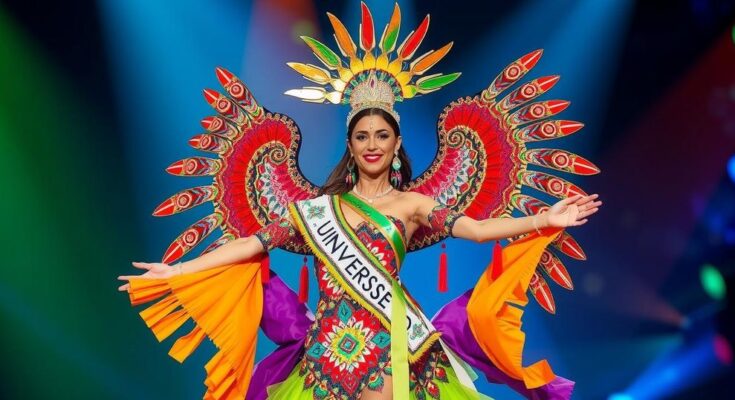The 73rd Miss Universe competition, held in Mexico City, celebrated cultural diversity through a vibrant display of national costumes by over 130 contestants. These outfits showcased deep cultural significances and narratives, culminating in an exciting contest that honors individuality and heritage. As audiences eagerly await the finale, the event emphasizes representation, resilience, and the empowerment of women worldwide, reflected in the artistry of each contestant’s costume.
The 73rd Miss Universe competition commenced in the vibrant heart of Mexico City on November 14, 2024, showcasing an extravagant parade of national costumes that dazzled audiences worldwide. Over 130 contestants stepped onto the stage, each donning outfits that narrate the rich tapestries of their cultural heritages, brimming with creativity and symbolism. Not merely fashion statements, these costumes represent stories of history, tradition, and national pride, transforming the event into a celebration of global diversity and unity. The national costume contest is a pinnacle of the pageant, with each contestant crafting a visual narrative through their design. Miss Canada, Ashley Callingbull, stole the spotlight in a breathtaking gown embodying the strength of Indigenous women, illuminated by twinkling lights symbolizing galaxies, reflecting generations of wisdom. Each element in her attire resonated power and cultural significance, enhancing the intrinsic beauty of diversity. Miss Malta, Beatrice Njoya, at the seasoned age of 40, charmed the crowd with her picturesque maritime tribute. Her stunning attire, a palette of red and white complete with boating symbols, emphasized an urgent message of marine conservation, intertwining culture with environmental awareness. Such narratives carved from natural elements reflect the heart of each country, as they envelop the audience in a visual journey across the globe. Sakhile Dube from Zimbabwe exhibited an artistic metamorphosis into the “Soaring Eagle,” where colored wings and stone-like trains conjured the landscapes of her homeland, especially the majestic Victoria Falls. The grandeur of her costume wasn’t merely for aesthetics but served to evoke a sense of national pride and cultural belonging. In tandem with these displays, Miss India, Rhea Singha, embraced the title “Sone ki Chidiya,” symbolizing wealth and prosperity through an impressive, armor-like costume. Its golden wings and helmet captured the essence of India’s rich cultural heritage, while Miss Philippines, Chelsea Manalo, embodied her nation’s religious diversity with her ethereal gown, intricately adorned with the Virgin Mary imagery and traditional dance motifs, shining amidst the festivities. The host nation, represented by Maria Fernanda Beltran, brought life to Indigenous culture with a costume rich in feathers and glimmering elements, epitomizing the vibrant spirit of Mexico. Meanwhile, Miss Jamaica, Rachel Silvera, showcased a playful beach-themed outfit that harmonized with the lively rhythm of her homeland, connecting audiences to the joyous essence of Jamaica’s coastal life. These spectacular displays culminate in a shared narrative of representation and resilience, as contestants set the stage not just to compete but to inspire. The hairstyling, the intricate designs, and the heartfelt stories weave together a vibrant tapestry of identity, showcasing the profound significance behind each outfit and the enthusiasm to embrace cultural narrative. As the final day looms near, anticipation swells with each breathtaking presentation, heightening the excitement for the crowning moment. This celebration of cultural craftsmanship serves as a platform for inclusivity, embracing the values of Miss Universe as it endeavors to empower women across the globe. It’s not merely about winning a title, but a powerful reminder that beauty exists in every corner of the world, enhancing our global tapestry. With the stage set for the next chapter in Miss Universe history, audiences remain captivated, eager to witness the culmination of individuality and collective heritage at its finest.
The Miss Universe pageant is renowned not only for its beauty competition but also for its cultural showcases. Each year, the national costume contest stands out, allowing contestants to express their heritage creatively. As a reflection of their nations’ rich traditions, these costumes often carry significant cultural meanings, celebrating diversity and unity on a grand scale. The 73rd Miss Universe competition highlighted this tradition beautifully, with many contestants presenting costumes that spoke to ecological awareness, cultural pride, and personal identities, further enriching the event’s narrative.
In summary, the 73rd Miss Universe contest exemplified the profound interconnectedness between beauty and cultural heritage. Through stunning costumes and heartfelt stories, contestants showcased their diverse backgrounds and perspectives. This year’s event highlighted how beauty transcends mere aesthetics, transforming into a celebration of stories, traditions, and identities. As anticipation builds toward the crowning moment, the competition underscores the importance of inclusivity and cultural appreciation, ensuring that the legacy of Miss Universe continues to shine brightly.
Original Source: evrimagaci.org



